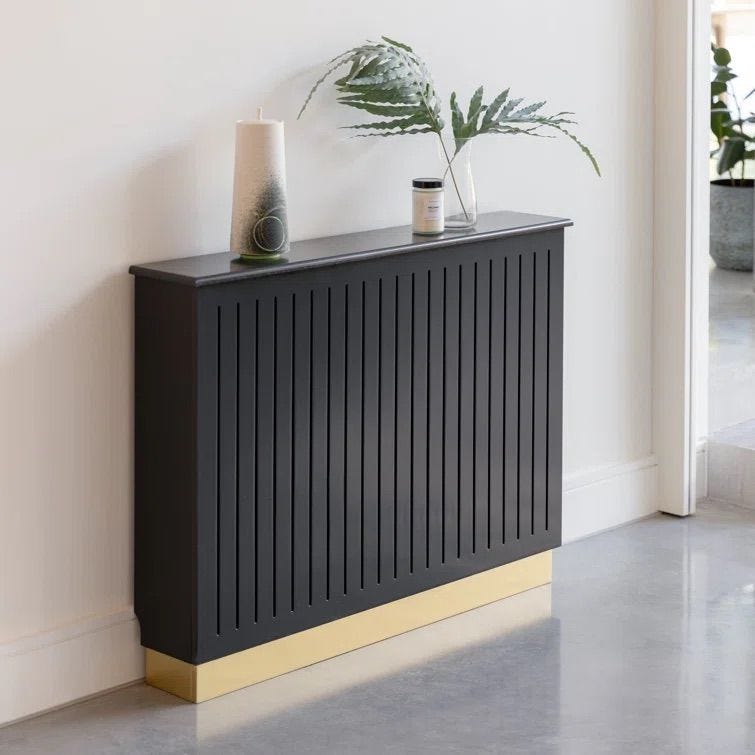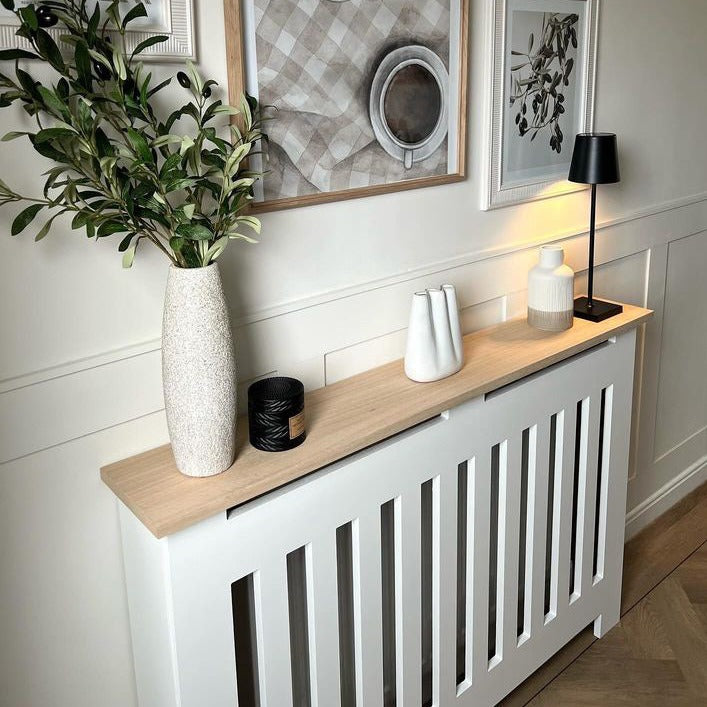Comparing wood radiator covers vs. Metal: Which Is Right for You?
Comparing wood radiator covers vs. Metal: Which Is Right for You?
Blog Article
The Relevance of a Radiator Cover for Enhancing Home Visual Appeals and Security
Radiator covers serve a twin function in the home, providing both visual enhancement and security benefits. They can transform a practical heating aspect right into a sophisticated design function, while additionally supplying a barrier versus unintentional burns. Picking the right cover can greatly affect an area's atmosphere. The selection of material and design can be challenging. Comprehending these facets is important for any kind of homeowner seeking to balance style and security efficiently.
The Practical Benefits of Radiator Covers
Radiator covers deal numerous useful benefits that enhance both the performance of furnace and the overall aesthetics of a space. Mainly, these covers assist to guide warmth extra evenly throughout a room, preventing locations and guaranteeing a comfortable environment. By encasing the radiator, they secure it from dirt and particles, which can prevent its performance. Additionally, radiator covers can lower warmth loss by lessening the quantity of cozy air that leaves right into unoccupied areas.Safety is another important facet; covers can protect against accidental burns, especially in homes with children or animals. Furthermore, they create a barrier that dissuades items from being placed directly on the radiator, which can pose fire hazards. Generally, radiator covers not just enhance heating efficiency but additionally add to a safer home, making them an important consideration for any kind of home.
Enhancing Home Visual Appeals With Style
Radiator covers deal an one-of-a-kind chance to improve a home's visual appeal via different layout choices. With a wide variety of products, styles, and shades offered, house owners can easily coordinate these components to match their interior style. This convenience enables for both functionality and visual enhancement in any kind of space.
Design Convenience Options
While numerous homeowners concentrate on functionality when picking heating solutions, the visual charm of radiator covers should not be forgotten - wood radiator covers. Radiator covers deal a wide variety of style convenience, enabling them to seamlessly mix with various interior designs. From streamlined, modern styles that complement contemporary rooms to ornate, vintage-inspired covers that boost traditional style, there is a cover to fit every preference. In addition, personalized alternatives allow homeowners to select colors, patterns, and surfaces that integrate with their existing home furnishings and wall treatments. This versatility not only enhances the general visual of a space yet additionally allows for innovative expression, transforming an often neglected aspect right into a stylish prime focus. Eventually, the ideal radiator cover can raise a room while maintaining comfort
Material Options and Designs
Picking the best materials for radiator covers greatly impacts both looks and functionality within a home. Common materials include wood, metal, and MDF, each offering unique designs and benefits. Wooden covers radiate warmth and charm, making them suitable for traditional or rustic insides. Steel choices, commonly smooth and contemporary, supply a modern touch while assuring resilience. MDF, a functional and cost-efficient choice, can be easily repainted or ended up to match any type of decoration. The layout style should line up with the general theme of the home, whether minimal, commercial, or classic. Eventually, selecting the ideal product not only enhances the aesthetic charm of the space but additionally ensures security and effective warmth circulation, striking a balance in between type and feature.
Color Coordination Methods
Color control plays a necessary role in boosting home visual appeals, specifically when incorporating radiator covers into the general design scheme. Choosing a shade that matches existing décor can develop a harmonious setting. As an example, a neutral cover can mix effortlessly with walls, while a strong shade can function as a striking focal factor. Patterns or structures can additionally be employed to add deepness and rate of interest, making sure the radiator cover adds positively to the area's ambiance. Furthermore, coordinating the cover's shade with furniture or accents can link the area. Homeowners ought to take into consideration the overall color scheme and lighting, as these aspects affect just how colors engage, inevitably boosting both style and security within the home.
Safety First: Safeguarding Your Family
Making sure a secure home atmosphere is vital, especially when little ones or animals are existing. Radiators, while vital for heating, can posture significant hazards. Their steel surface areas end up being very hot during procedure, creating a risk of burns if touched. A radiator cover acts as a reliable obstacle, safeguarding at risk relative from unexpected call with these heated surfaces.In enhancement to stop burns, radiator covers help to get rid of sharp sides and sticking out components that could lead to injuries. By enclosing the radiator, they additionally lower the likelihood of items falling onto the heating component, which can develop fire threats. Moreover, a well-designed cover can discourage children from making use of the radiator as a play surface area, therefore decreasing the threats of falls or other crashes. Ultimately, purchasing a radiator cover not only boosts the visual charm of a home yet substantially adds to the security and well-being of its inhabitants.
Picking the Right Product for Your Radiator Cover
When it involves picking a radiator cover, the product plays a considerable role in both capability and visual appeals. Usual options include timber, metal, and MDF, each offering distinct benefits (radiator cover store). Wooden covers provide a cozy, classic appearance and can be quickly customized with spots or paints. They might not be perfect for damp settings, as moisture can warp the material over time. Steel covers, often made from steel or aluminum, deal longevity and a modern-day aesthetic yet may call for additional insulation to avoid warm loss. Meanwhile, MDF is cost-effective and flexible, enabling various finishes, though it may not stand up to high temperatures as well as other materials. Ultimately, the choice of material should straighten with the property owner's design choices, the intended area of the radiator cover, and any particular functional requirements, making certain an excellent balance between kind and feature

Layout Ideas to Complement Your Design
While a radiator cover serves a useful function, it can also enhance a room's general visual. Different design ideas can transform a fundamental cover right into an attractive focal point. For contemporary insides, streamlined metal or minimalist wood layouts can offer an innovative touch. On the other hand, rustic homes might take advantage of reclaimed wood covers, which include warmth and character.Painted radiator covers can seamlessly blend with wall shades, creating a cohesive look, while patterned textiles can present appearance and visual interest.In spaces with a vintage ambiance, luxuriant styles or attractive grilles can evoke a sense of fond memories. Furthermore, including shelves on top of the cover can supply functional room for plants or decorative products, better enhancing the decor.Ultimately, the option of layout ought to mirror the property owner's individual design, guaranteeing that the radiator cover enhances the total theme of the space.
Installment Tips for a Smooth Fit
Appropriate setup of a radiator cover starts with exact measurements to ensure a tight fit. Picking the appropriate material is similarly crucial, as it affects both functionality and aesthetic appeal. Complying with these guidelines can substantially enhance the general look and performance of the radiator cover.
Procedure Your Radiator Properly
Exact dimensions are vital for accomplishing a smooth fit when mounting a radiator cover. One should gauge the size, height, and deepness of the radiator, making sure to catch the most protruding components. It is suggested to make use of a tape action for accuracy, keeping in mind measurements in both inches and centimeters for adaptability. Additionally, gauging the range from the floor to the top of the radiator assists in determining how high the cover must sit. Taking into consideration any pipelines or valves that might prolong from the radiator can stop future problems. It is wise to verify measurements to prevent errors, as even mild inconsistencies can lead to uncomfortable covers that compromise both visual appeals and capability.
Choose the Right Product
Selecting the proper product for a radiator cover is important for both capability and aesthetic appeals. Various products, such as timber, metal, and MDF, deal unique benefits. Wood supplies a cozy, traditional appearance but may call for normal upkeep to avoid warping. Steel is sturdy and can endure heats, yet might not blend effortlessly with all indoor designs. MDF, while affordable and flexible, might not be as heat-resistant as other options. It is necessary to consider the desired environment; for example, a bathroom might gain from moisture-resistant materials. Furthermore, matching the cover with existing style improves the general layout. Inevitably, the picked product must stabilize style, durability, and security to assure a seamless fit and enduring allure in any home.
Upkeep and Take Care Of Radiator Covers
While radiator covers can improve the visual allure of a room, their maintenance and treatment are important for making certain perfect performance. Normal cleansing is vital to protect against dust buildup, which can block warm circulation. Utilizing a soft fabric or duster will suffice; harsh chemicals should be stayed clear of to shield the surface of the cover.Inspecting the cover regularly for any kind of indicators of damage, such as corrosion or warping, is likewise important. Immediate fixings can prolong the lifespan of the cover and preserve its appearance. For wood covers, occasional sprucing up might be required to keep the coating intact and prevent drying out or cracking.Additionally, making sure that the cover is correctly fitted and securely affixed to the wall can avoid mishaps, especially in homes with youngsters or family pets. By prioritizing upkeep, house owners can delight in both the visual and practical advantages of their radiator covers for years to find.
Regularly Asked Concerns

Can Radiator Covers Improve Power Effectiveness in My Home?
Radiator covers can possibly improve energy performance by directing warmth right into the space as opposed to losing it directly to walls. This may result in a much more constant temperature and reduced energy consumption with time.
Are There Certain Radiator Cover Styles for Vintage Homes?
Radiator covers for vintage homes typically include elaborate styles, such as complex carvings or traditional patterns - metal radiator covers. Styles like Art Deco or Victorian can match the home's architecture while providing functional advantages. Personalized choices are additionally available
Exactly how Do I Gauge My Radiator for a Cover?
To wood radiator covers determine a radiator for a cover, one need to note the elevation, size, and depth. In addition, measuring any type of outcroppings or fixtures ensures a correct fit, enabling the choice of an appropriate and functional radiator cover.
Can I Tailor a Radiator Cover to Fit My Decor?
Yes, personalizing a radiator cover to fit specific design is feasible. Choices consist of choosing products, shades, and creates that complement existing furnishings, enabling for a seamless assimilation right into the general aesthetic of the space.
What Are the Most Usual Products Utilized for Radiator Covers?

Report this page